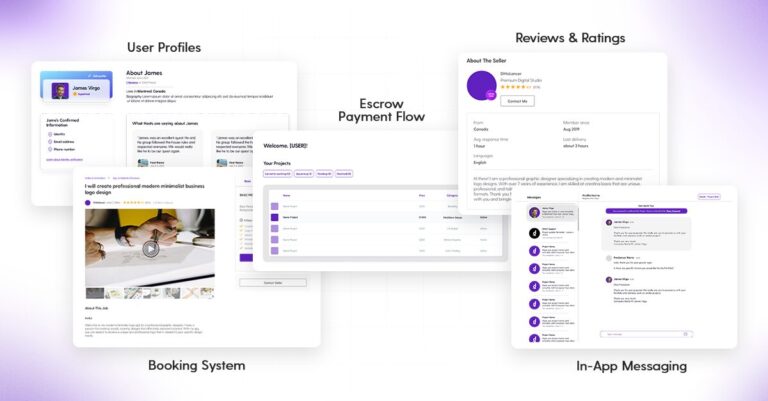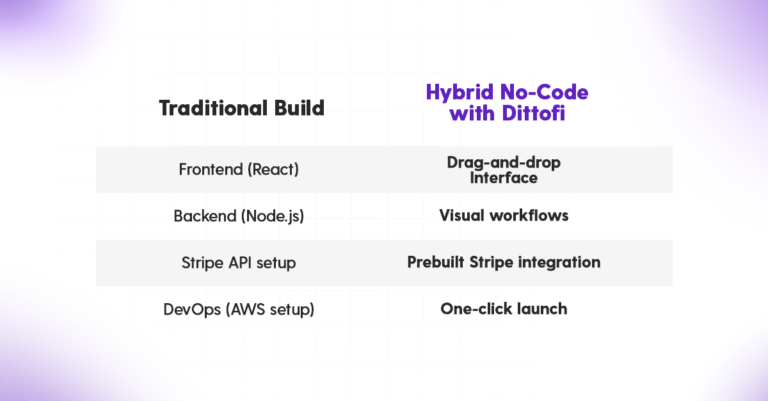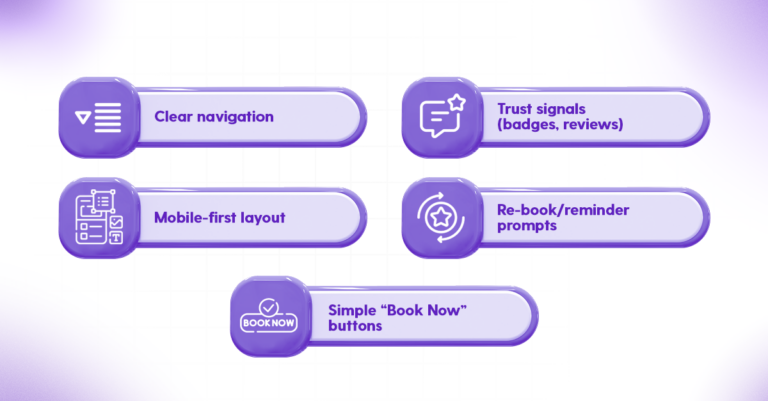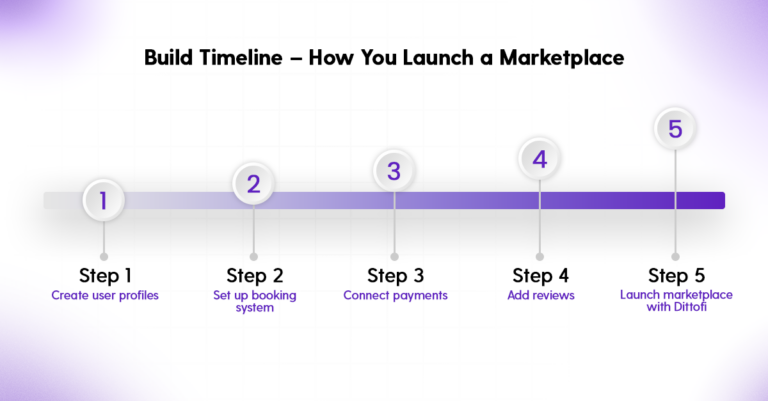Intro: The Marketplace Revolution — Simplified
If you’re reading this, chances are you’ve spotted the opportunity. Service marketplaces are booming — from multi-billion-dollar platforms like Upwork and Fiverr to niche startups connecting local cleaners, consultants, or coaches with paying customers. But if you’ve ever tried to build a marketplace from scratch, you know it can feel overwhelming — especially if you’re not a developer.
The good news? It’s 2025, and building a powerful, scalable marketplace doesn’t require a full dev team or a $100K budget. With modern hybrid no-code tools like Dittofi, anyone — from solo founders to growing startups — can launch, test, and scale a custom marketplace in a fraction of the time.
In this guide, we’ll walk you through everything your marketplace needs to succeed — and how you can build it step-by-step using hybrid no-code.
We’ll show you:
- What core features every marketplace needs (and why)
- How Dittofi handles the tech behind them — without complex code
- The UI/UX patterns that increase trust, bookings, and retention
- How to go live faster than ever — while keeping full control over your platform
Whether you’re in the early stages of building or already mapping out your MVP, this blueprint will help you turn your service marketplace idea into a working product — quickly, securely, and with room to grow.
What Your Marketplace Needs to Work (Core Features)
Let’s start with the building blocks. Every successful service-based marketplace — from Airbnb to TaskRabbit— relies on a few core components to drive user experience and business value.
Let’s walk through them — and how modern hybrid no-code tools make them accessible, even without technical experience.
1. User Profiles: Where Trust Begins
In a service marketplace, trust is currency. And user profiles are where that trust is built. Whether someone is offering personal training sessions, interior design consultations, or dog walking, buyers want to know exactly who they’re hiring — and why they should feel confident doing so.
That’s why well-designed profiles go beyond the basics. They’re not just about a name and photo. The best platforms showcase a provider’s experience, services, pricing, reviews, portfolio, and even availability. On the customer side, profiles may be more lightweight, but they still play a role in maintaining platform transparency and communication history.
The key is giving users enough room to represent themselves, while maintaining structure so everything stays readable and relevant. For founders, this usually means setting up custom database fields, enabling profile editing permissions, and managing visibility settings between different user roles. In traditional development, that can be a backend-heavy lift. But with modern no-code platforms like Dittofi, you can build out sophisticated user role systems and dynamic profile pages visually — with the backend logic already baked in.
Another often overlooked feature? Verification workflows. Allowing users to upload credentials, pass background checks, or earn “trusted provider” badges can increase trust significantly — especially in marketplaces dealing with high-touch or in-home services.
And finally, think about the future. Profiles should be extensible, not fixed. You may want to let users earn badges, track repeat customers, or add service bundles later. A flexible profile system sets you up for future feature rollouts without a total rebuild.
2. Booking Systems: The Engine of Your Marketplace Website
Once a user decides to hire someone, the very next thing they want to do is schedule. That’s where a marketplace’s booking flow either makes or breaks the experience. If it’s clunky or confusing, you’ll lose conversions. If it’s seamless, you’ll build momentum — and repeat customers.
At its core, a booking system connects user interest with provider availability. But there’s nuance. Do users need to choose time slots? Will providers accept or reject manually, or should bookings be auto-approved? Does the platform need to handle cancellations, rescheduling, and time zone conversions?
These are more than UX decisions — they’re business model decisions. The way you structure bookings can shape how users engage and whether your marketplace feels smooth or frustrating.
For instance, service marketplace platforms like TaskRabbit or Handy rely on instant scheduling for speed and scale. Others, like Upwork, lean more into messaging before booking. Knowing what your users expect (and what your providers can manage) will help you define your ideal flow.
In traditional dev workflows, a calendar-based booking engine might involve building custom logic, integrating third-party libraries, syncing with tools like Google Calendar, and adding notifications. It’s doable — but costly and time-intensive.
Here’s where no-code earns its value. Marketplace software like Dittofi offer a visual environment to build custom workflows, connect user databases with availability calendars, and automate reminders or status changes — all without touching raw code. You can create booking forms that pull from a provider’s availability, confirm a booking, and trigger follow-up actions like payments or review requests — build a marketplace without coding (and customize it if you would like to do that).
Ultimately, great booking is invisible. Users don’t think about it. They just pick a time, hit “confirm,” and move on. But behind the scenes, a lot needs to happen. With the right setup, you can give users a seamless experience — and keep control of the complexity.
3. Payments & Escrow: Where Safety Meets Simplicity
If trust starts with profiles and booking, it’s solidified with how you handle money. Payments are the heartbeat of any service marketplace platform — where value is exchanged, confidence is built, and disputes are either prevented or exacerbated.
But payment processing is more than just hooking up Stripe and hoping for the best. You need to think about how money flows through your platform: Who gets paid? When do they get paid? What happens if something goes wrong?
Escrow is one of the smartest tools in a service marketplace’s toolkit. It works like this: a customer pays upfront, the funds are held by the platform or a third-party provider, and then released to the service provider once the work is completed and approved. This protects both parties. Buyers feel safer knowing their money isn’t gone if a provider fails to deliver. Sellers, meanwhile, can see that the funds are real and reserved, giving them peace of mind before investing their time.
Freelance marketplace software like Upwork, Rover, and Toptal use escrow mechanisms to build this kind of two-way trust. But implementing escrow in a traditional dev stack? Not so simple. It often requires deep Stripe API integration, transaction routing logic, refund workflows, admin controls, and error handling. For non-technical founders, that’s a wall of complexity.
With modern no-code solutions like Dittofi, this functionality becomes far more approachable. You can define payment flows visually: trigger when a payment is initiated, when it’s held, and when it’s released. You still get full control — who sees what, when funds move, and how disputes escalate — but you skip the months of backend development.
Even if you’re not ready for full escrow on day one, think ahead. How will you support partial payments? Refunds? Service add-ons? A flexible payments architecture gives you room to grow. And when it’s done right, users won’t think about it. They’ll just feel safe.
4. Reviews & Ratings: The Social Proof Flywheel
Nothing moves the needle in a marketplace quite like a 5-star review. Or — conversely — nothing kills momentum like a string of bad ones. Reviews are more than vanity metrics. They’re the social proof that tells users, “This platform works.”
But here’s the nuance: a review system isn’t just a form on a page. It’s a trust engine. When designed well, it encourages honesty, discourages abuse, and helps great providers rise to the top. When done poorly, it’s either ignored or weaponized.
The best marketplaces create review systems that are fair, timely, and contextual. For example, reviews should only be allowed once a transaction is completed. Both parties should have the chance to share feedback. And ideally, you’d avoid showing one party’s comments until both have submitted — preventing retaliation or bias.
Star ratings are the standard, but they’re not everything. Written feedback, verified badges, service-specific tags (e.g., “great communicator” or “on-time”), and aggregated performance stats all add richness. They help new users make decisions — and help providers build credibility faster.
And don’t forget moderation. Especially in community-driven or niche marketplaces, you’ll want admin tools to flag offensive content, resolve disputes, or remove fake reviews. This isn’t about censorship — it’s about quality control.
From a technical side, building a review system from scratch involves complex database relationships (users rating other users), permissions, and notification logic. If you’re a developer, you know it’s a multi-step workflow. If you’re not, it may sound like a showstopper.
That’s why hybrid no-code platforms like Dittofi shine here. You can design review flows as part of your service journey — triggering prompts automatically, storing data cleanly, and even surfacing insights on user dashboards or provider profiles. It feels native, but it’s built visually.
Bottom line: people trust people. The more social proof your platform builds, the less selling you have to do. Reviews turn first-time users into repeat customers—and top-rated providers into magnets for new business.
5. In-Platform Messaging: Conversations That Convert
Think about the last time you booked a service from someone new. Did you hit “buy” immediately — or did you reach out first? In service marketplaces, especially where the offering is personalized, one quick message can be the tipping point between hesitation and commitment.
That’s why messaging matters. A lot.
Service marketplaces aren’t like Amazon. They’re human-driven. Buyers often want to ask questions, clarify deliverables, or just get a feel for who they’re working with. A built-in messaging system gives them that comfort — and helps providers pre-qualify leads, set expectations, and close deals faster.
But here’s where it gets tricky: if you’re not careful, messaging can become chaotic. Off-platform conversations (via email or WhatsApp) pull users out of your ecosystem, which means:
- You lose visibility
- You lose control
- You lose potential revenue
The solution? Keep it all in-house. Your platform should enable direct, secure communication — but on your terms.
That usually means features like:
- Real-time chat or asynchronous inboxes
- Notifications (email or in-app) for new messages
- Threaded conversations tied to bookings or users
- Admin oversight for safety and dispute resolution
And depending on your audience, you might want extras like file sharing, service proposal templates, or group chats.
In traditional development, real-time messaging means spinning up WebSocket servers, integrating third-party tools (like Twilio or Firebase), and managing user permissions across chat states. It’s powerful — but also developer-heavy.
Hybrid no-code platforms like Dittofi give you a shortcut. You can build secure, user-to-user messaging features using prebuilt backend logic, dynamic user ID routing, and customizable UI components. Want to add message history to a provider’s dashboard? Done. Need to auto-flag keywords or spam? Easily implemented with backend workflows.
Even more importantly, messaging doesn’t just serve your users — it serves your business. It keeps conversations (and transactions) inside your platform. It drives engagement. And it gives you the data and control you need to resolve issues fairly.
In short: conversations lead to conversions. If you want your service marketplace to feel alive — and trustworthy — messaging can’t be an afterthought. It’s a core pillar.

What’s Under the Hood: The Tech Stack of a Million-Dollar Marketplace (And Why Dittofi Makes It Easy)
Here’s the thing most first-time founders discover the hard way: even a “simple” marketplace is powered by a very not-simple tech stack. Booking a coach? Paying a dog walker? Leaving a review? Those tiny interactions require a surprising amount of infrastructure working in harmony behind the scenes.
Let’s break it down.
A traditional service marketplace platform often relies on a multi-layered stack, which can include:
- Frontend: Usually built with React, Vue, or Angular for responsive, interactive user interfaces.
- Backend: Node.js, Ruby on Rails, or Firebase functions handle server-side logic, data processing, and API calls.
- Database: MongoDB, PostgreSQL, or Firebase to store user data, bookings, messages, payments, etc.
- Authentication: Custom or third-party (e.g., Auth0) to handle logins, user roles, and sessions.
- Payments: Stripe, PayPal, or Braintree integrations to process transactions, hold funds, and issue payouts.
- Hosting/DevOps: AWS, Vercel, or Google Cloud to manage deployment, scalability, monitoring, and uptime.
That’s a lot of moving pieces — and a lot of developers, DevOps engineers, and QA time to pull it all together. Even a clean MVP can take 3–6 months and burn through $50K–$100K in early development.
So what’s the alternative?
The Rise of the Unified, Hybrid No-Code Stack
Today, hybrid no-code platforms like Dittofi are changing the game — not just by offering templates, but by replacing the full-stack complexity with a single, powerful visual environment. Here’s what that looks like in practice:
- Visual Frontend Builder: Instead of writing React components, you drag, drop, and design responsive pages using a pixel-perfect builder — while still customizing behaviors using logic workflows and data bindings.
- Visual Backend Logic: Instead of coding backend APIs or custom endpoints, you create workflows visually. Need to fetch available providers, filter by date, and display them? That’s a workflow, not a script.
- Built-in Database: Define your data models visually, manage records, and build relationships without writing a single SQL query.
- Auth, Roles & Permissions: Dittofi handles authentication, user role-based access, and protected routes — out of the box.
- Integrated APIs: Want to bring in Stripe? Use the Stripe API connector. Need to integrate with Calendly or Zapier? You can add third-party services through clean, manageable REST/GraphQL integrations.
- Instant Hosting & DevOps: No need for Heroku or AWS just to go live. With Dittofi, you deploy with one click — and it scales as you grow.
In short: you’re not patching together 12 tools and hoping they play nice. You’re building inside one ecosystem — with full control over your logic, data, and UX.
What That Means for Founders
If you’re non-technical, this is your way in. If you’re technical, this is your speed boost. Either way, you skip the version 1.0 headaches and get to market faster — with more control over your roadmap and fewer expensive rebuilds later.
You don’t need to be a dev. You just need to be dangerous enough to launch. And with the right tools, you can build a platform that feels like it came from a 10-person engineering team.

UI/UX Best Practices for Service Marketplaces: What Drives Bookings & Retention
Let’s say you’ve nailed the backend. Your booking logic is solid, payments are smooth, and your messaging system works flawlessly. Great. But here’s the thing — if your design doesn’t feel trustworthy or easy, none of that matters.
In a service marketplace, your UI (user interface) and UX (user experience) aren’t just “nice to have.” They’re the frontline. They’re the difference between someone booking a service — or bouncing in 10 seconds. Between a loyal user — and a confused visitor.
So what makes a marketplace feel high-converting and trustworthy?
1. Clear, Fast, Focused Navigation
Service marketplaces succeed when users can:
- Find what they need fast
- Filter and sort results based on their preferences
- Understand how to book in just a few clicks
Take a cue from TaskRabbit: their homepage leads you to “What do you need help with?” — then funnels you straight into categories. Dittofi gives you full control over your site’s navigation and layout, so you can build similar guided flows without coding menus from scratch.
2. Trust Signals at Every Step
Design isn’t just about aesthetics — it’s about credibility. Platforms like Upwork and Fiverr use:
- Star ratings
- “Verified” badges
- Reviews with profile pictures
- Completion stats (“95% on-time delivery”)
- Secure payment icons and guarantees
You don’t need to be huge to borrow these patterns. You just need to structure your data smartly and present it clearly. Using a hybrid no-code platform like Dittofi, you can show user reviews, ratings, and completion metrics on provider profiles automatically — reinforcing trust without adding friction.
3. Mobile-First, Always
Let’s be honest: most of your users will experience your platform on their phones. That means you need pages that load fast, buttons that are tappable, and booking flows that don’t require a desktop to complete.
Dittofi’s visual builder outputs fully responsive layouts, so you can design once and deploy everywhere — ensuring your UX feels natural on every screen size.
4. Feedback Loops = Stickiness
Great UX doesn’t end when the service is booked. The best platforms use nudges to keep users engaged:
- “Rate your provider” emails
- Dashboard reminders
- Re-book buttons
- Personalized recommendations
With logic-driven workflows, you can automate these nudges using no-code tools. The result? Higher retention, more repeat bookings, and better platform stickiness.
5. Simplify. Then Simplify Again.
When in doubt, remove clicks. Reduce choices. Clarify the next step. Great design isn’t about stuffing your page with features — it’s about making sure users understand exactly what to do, when to do it, and why they should trust you to handle it.
Every decision — from the placement of your “Book Now” button to the copy in your tooltips — impacts your conversion rate. So don’t just build. Test. Iterate. Refine.
A great UI earns trust. A great UX removes friction. Together, they make your platform more than a website — they make it feel like a product users want to come back to.

From Blueprint to Live Marketplace — Fast
When you’ve got a clear idea of what you want to build — and you understand the core features that power every great service marketplace — the next step is turning that vision into something real. That’s where most founders get stuck.
They either fall into the long, winding road of traditional development (hello, dev sprints and budget overruns), or they get overwhelmed by the sheer number of moving pieces it takes to stitch a platform together.
But here’s the truth: building a custom marketplace in 2025 doesn’t have to be hard. It doesn’t have to be expensive. And it definitely doesn’t have to take six months just to launch an MVP.
The difference today is in the tools. With platforms like Dittofi, founders are skipping the dev queue and going straight from idea to live product—visually. Instead of hiring a backend developer to set up a database, or a front-end engineer to build every button, you design your platform like a blueprint. Page by page. Workflow by workflow. Logic and design, all in one.
And because everything is built with real code behind the scenes — not just templates or page builders — you’re not boxed in. Your app grows with you. Need to add Stripe payments? Done. Want to launch a new feature for premium providers? No problem. You stay agile and in control.
For many of the founders we work with, that speed and flexibility is everything. It’s the reason they’re testing in weeks instead of months. It’s how they’re onboarding early users, getting real-world feedback, and growing faster than they thought possible.
So if you’ve been holding back — waiting to “figure out the tech” or find the right developer — consider this your sign. The roadmap is clearer than ever. The tools are ready. And the opportunity? Still massive.
You don’t need to be technical to build something remarkable. You just need to start.

Curious what scaling will actually cost?
Check out our full breakdown on how to scale your online marketplace efficiently — and what most founders overlook.
Wrapping Up: Building a Service Marketplace Platform Isn’t Out of Reach Anymore
We’ve covered a lot — what goes into a great service marketplace, how to design around your users, how to simplify the tech stack, and what it actually takes to launch. And here’s the big takeaway:
You don’t need to reinvent the wheel. But you do need a real plan — and the right tools to execute it without burning time or budget.
The best part? You can start small. Launch with just the essentials, get your first users, and evolve as you grow. Whether you’re building for a local niche, a global audience, or a tight-knit professional network, a service marketplace is one of the smartest, most scalable digital businesses you can build today.
And now, you have the blueprint to do it.
Build Your Marketplace. Skip the Dev Team.
Turn your service marketplace idea into a live product — complete with bookings, payments, and messaging.

